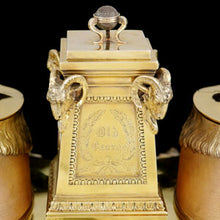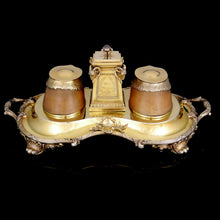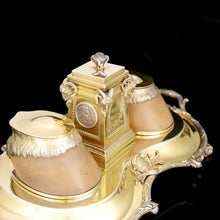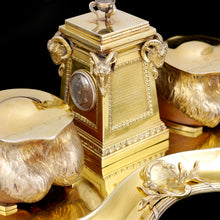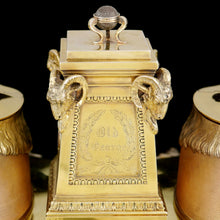Waterloo Centrepiece - Field Marshal Sir William Gomm’s Tribute to His War Horse, 1842
- Regular price
- £28,000
- Sale price
- £28,000
- Regular price
-
- Unit price
- /per
Adding product to your cart
Overall: 20cm (8in) x 49cm (19.2in) 28cm (11in)
Total weight: 3802g (122.25oz)
Silver-gilt centrepiece raised on a shaped base with a ribbon-tied reeded border and cartouches on either side engraved with the Field Marshal’s armorials, raised on four shell and scroll feet, the base mounted with twin horse hoof lidded compartments flanking a pedestal form tapering container set with two Waterloo Medals (1815), one named to Thomas Mackley, 2nd Batt Coldstream Guards, and the other to Staus Bannister, Royal Artillery Drivers, the front of the central container inscribed ‘Old George’ and the back bearing a Latin memorial inscription:
‘In memory of an excellent war horse, who in his best years, at the Battle of Waterloo received a grave wound, the witness of which is this lead bullet extracted after his death and placed between two of his hoofs. In his old age he was settled in the meadows at Stoke Park in the county of Buckinghamshire where he was most warmly received and in the greatest happiness on his final day. He died on 28 December 1840 at the age of 33. He lies with full honours in that welcoming field which he loved most.’
Read more
Maker’s marked of Storr & Mortimer, New Bond Street, London. Hallmarked London 1842.
The present centrepiece commemorates the Field Marshal Sir William Gomm’s loyal and long-lived war horse ‘Old George’ who carried his master through shot and shell in the Waterloo Campaign of 1815. Sir William Maynard Gomm GCB (1784-1875) was just nine years old when he joined the 9th Regiment of Foot in 1794. He served throughout the Napoleonic Wars and ultimately rose to become Commander-in-Chief, India, and in 1863 Colonel of the Coldstream Guards in succession to Lord Clyde. He was further promoted to Field Marshal in 1868. His home Stoke Park in Buckinghamshire was owned by John Penn, the uncle of Sir William’s wife, Sophia. Old George's gravestone can still be seen there today. The house was designed by James Wyatt in 1788, with grounds laid out by Lancelot 'Capability' Brown and Humphry Repton. The house has been used for several movies including Goldfinger, Tomorrow Never Dies, and Layer Cake. The house was converted into a country club in 1908.
Sir William Gomm’s military career began when he was nine years old. The son of an officer who was killed in action in the French Revolutionary Wars, he was granted a commission as an ensign in the 9th Regiment of Foot on 24 May 1794, in recognition of his father’s services. Promoted to lieutenant in 1795, he continued in full-time education at Woolwich. At 14 he joined his regiment in Holland and was wounded in action while serving under the Duke of York against the French revolutionary forces. After participation in the expedition to Ferrol, Spain in 1800 and, attending the new Royal Military College at High Wycombe, he served as Assistant Quartermaster-General (AQG) under Earl Cathcart at the Battle of Copenhagen in August 1807. He joined Wellington’s Peninsula Army in 1808, and, rising to the rank of Lieutenant-Colonel by the time he was 28, he served in the siege of Badajoz, earning himself a Small Army Gold Medal. He continued in the capacity of AQG at Salamanca, Vittoria, Sebastian and Nive earning an Army Gold Cross for the five major actions he had participated in.

By the time he was knighted KCB in January 1815, he had become one of the Duke of Wellington’s most trusted staff officers, and as such was rewarded by promotion to Lieutenant-Colonel in the Coldstream Guards. As AQG, Sir William’s responsibilities in the upcoming Waterloo campaign were arduous, as well as extremely dangerous. He was always at the front of the action executing his AQG duties and in his own words ‘in the hottest of all this glorious business’. He was heavily involved in the battlefield manoeuvring before the clash between Allied and French forces at Quatre Bras on 16 June. He led the 28th (North Gloucestershire) Regiment to occupy Gemioncourt, but found it already in the enemy’s possession. He and the regiment fell back to Quatre Bras, where the 28th stood firm in a tall field of rye while subject to continuous attacks from French cavalry under Marshal Ney.
Two days later on 18 June 1815, Gomm was engaged with the 5th Division at the battle of Waterloo in a defensive struggle against the onslaught of Napoleon’s Army. It should be noted that although he was on staff as AQG of Picton’s 5th Division, his own company from the Coldstream Guards was one of several companies of his regiment that heroically defended the farmhouse at Hougoumont and thus saved the battle from turning on Wellington. Among these was Coldstream Guardsman Thomas Mackley whose medal is inset into the centrepiece and who later became a Chelsea Pensioner. The other medal, awarded to Saus Bannister of Royal Artillery Drivers, represents one of some 2,600 trained and disciplined drivers fielded at Waterloo who were to provide efficient movement of guns, ammunition and supplies under the direction of the AQG’s such as Gomm. Picton’s 5th Division marched from Brussels to the battlefields of Quatre Bras and Waterloo with 5,270 officers and men. By the evening of 18 June they were reduced to half of this number through battle casualties. Sir William, however, escaped serious injury once again, although his cherished ‘George’ was shot under him during his service at both Quatre Bras and at Waterloo, but nevertheless lived to retire in Stoke Park and be buried there at the ripe old age of thirty-three.

Sir William continued to serve his country on active military duty for an astonishing 81 years, the longest continuous service of anyone in the history of the British Army. During his life, he was the veteran of many of the bloodiest battles of the Napoleonic Wars, rose to Commander-in-Chief of India, earned the utmost respect from his peers and held some of the highest honours his country.
The makers of the centrepiece Storr & Mortimer are regarded as one of the foremost manufacturing and retail goldsmiths of their day. Paul Storr, one of the finest English silversmiths of the period, left Rundell, Bridge & Rundell in 1819 to set up his own Clerkenwell workshop in 1819. In 1821 he formed a partnership with retailer John Mortimer who had just taken over a jewellery business in fashionable New Bond Street, London. Storr and Mortimer quickly established themselves as leading manufacturing and retail goldsmiths, jewellers and silversmiths with an influential clientele list that included Royalty and aristocracy - a legacy no doubt of the the reputation that Storr had established during his time employed by the esteemed Rundell, Bridge & Rundell. Paul Storr continued to make exceptional works in silver for both his own clients and also other firms such as the crown jeweller Garrard & Co. In 1826 they were joined by an additional partner, John Samuel Hunt, who brought with him £5,000 of investment capital. By 1838 they were established in new premises at 156 New Bond Street settling in just prior to the retirement of Paul Storr at the end of December that same year. This prompted a name change to Mortimer and Hunt which the business operated under from 1839 until 1843 when John Mortimer retired and the name changed again, this time to Hunt & Roskell.
Cf. ‘Letters and Journals of Field Marshal Sir William Maynard Gomm, GCB from 1799 to Waterloo, 1815’. Edited by Francis Culling Carr-Gomm. Published by London: John Murray, 1881.







